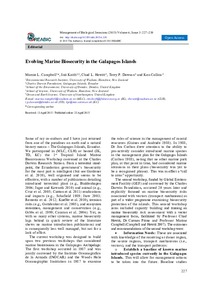Evolving Marine Biosecurity in the Galapagos Islands.

View/
Average rating
votes
Date
2015Author
Campbell, Marnie L.
Inti, Keith
Hewitt, Chad L.
Dawson, Terry P.
Collins, Ken
Metadata
Show full item recordAbstract
Some of my co-authors and I have just returned
from one of the paradises on earth and a natural
history mecca – The Galapagos Islands, Ecuador.
We participated in (MLC, CLH) or hosted (IK,
TD, KC) the 1st Tropical Island Marine
Bioinvasions Workshop convened at the Charles
Darwin Research Station. From a terrestrial standpoint, the Ecuadorian government’s biosecurity
for the most part is intelligent (but see Gardener
et al. 2010), well organised and seems to be
effective, with a number of publications detailing
introduced terrestrial plant (e.g., Buddenhagen
2006; Jager and Kowarik 2010) and animal (e.g.,
Cruz et al. 2005; Carrion et al. 2011) eradications
and impacts (e.g., Schofield 1989; Itow 2003;
Renteria et al. 2012; Kueffer et al. 2010), invasion
risks (e.g., Gottdenker et al. 2005), and ecosystem
restoration, management and conservation (e.g.,
Gibbs et al. 1999; Causton et al. 2006). Yet, as
with so many other systems, marine biosecurity
lags behind (a quick .....
Journal
Management of Biological InvasionsVolume
6Page Range
pp.227-230Document Language
enSustainable Development Goals (SDG)
14Maturity Level
Mature: Methodologies are well demonstrated for a given objective, documented and peer reviewed; methods are commonly used by more than one organization (TRL 7-9)Best Practice Type
GuideSpatial Coverage
Galapagos IslandsTropica East Pacific Ocean
DOI Original
http://dx.doi.org/10.3391/mbi.2015.6.3.01Citation
Campbell, M.L.; Keith, I.; Hewitt, C.H.; Dawson, T.P. and Collins, K. (2015) Evolving Marine Biosecurity in the Galapagos Islands. Management of Biological Invasions, 6, pp.227–230. DOI: http://dx.doi.org/10.3391/mbi.2015.6.3.01Collections
The following license files are associated with this item:
 Repository of community practices in Ocean Research, Applications and Data/Information Management
Repository of community practices in Ocean Research, Applications and Data/Information Management
